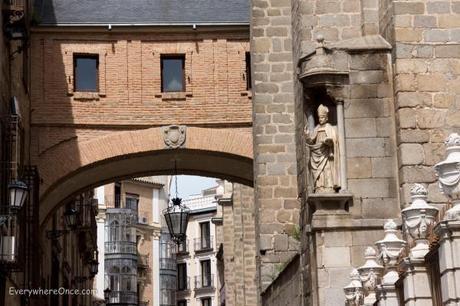
Of course the answer to the title question is “Yes.” If you have time, you should visit both. But when researching our own Spanish itinerary we saw so many people asking the question on various message boards that we thought we’d wade in with our own take.
Both Segovia and Toledo are medieval, walled cities that are within a 30-minute high-speed train ride away from Madrid. Which one you choose really comes down to what you’re looking for, how long you have to visit, and, if you’re on a very tight budget, how much you have to spend.
Segovia, for sure, is the prettier sister of the two. She’s sexy, alluring, and best of all, she’s easy. We found her to be the cheaper date as well.
In Segovia you can walk from the Roman Aqueduct on one end of town, past the city’s wonderful cathedral, and arrive at the castle all the way at the other end of town in about 15 minutes. Everywhere you turn during that walk, or along any random street you might take, is a feast for your eyes.
If it’s a quick one night stand you’re looking for, or maybe just a day trip, Segovia would be our first choice.
Toledo, meanwhile, is larger, somewhat – and really only somewhat – less comely, and can be a bit uncooperative. She compensates for these shortcomings by offering more depth than her flashier sister. If you have the time to get to know Toledo, she’ll reward you in ways Segovia simply cannot.
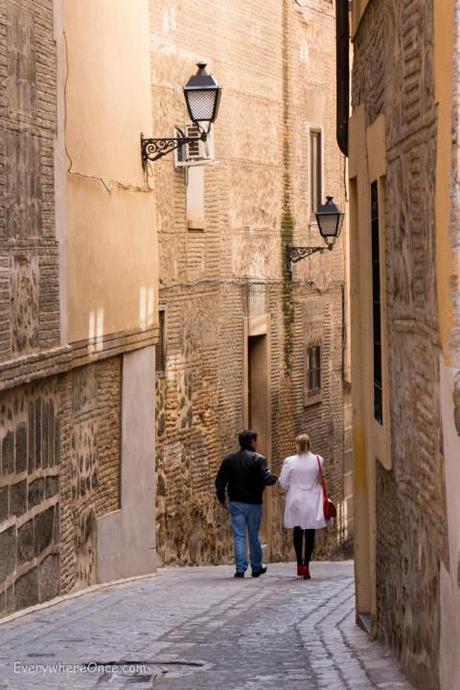
Walking the narrow streets of Toledo, Spain
But you do need a little more time here. Toledo is more sprawling and more confusing than Segovia. It’s easy to get lost here, which is only bad if you’re in a rush to get somewhere specific. You’ll more easily find residential areas in Toledo without souvenir stands. Unfortunately, most of these areas lack local pubs or coffee shops to sip a beverage while you indulge in the relative solitude.
Toledo is also harder to get around than Segovia. It’s a fairly hilly city that we didn’t walk so much as climb. If you have mobility issues or are planning on cramming in all of the city’s sites before catching the evening train back to Madrid, you may find the topography challenging.
And it’s doubtful you’d be able to get to everything anyway. There really is too much to see in Toledo. We spent three days in town and still left with plenty of things undone. That’s partly because of cost, though. Toledo has dozens of small attractions, each of which charges admission. There are 14th century synagogues (Sinagoga del Transito €3, Sinagoga de Santa Maria La Blanca €3), 11th century mosques (Mezquita del Cristo de la Luz, €2.50), 15th century monasteries (Monasterio San Juan de los Reyes €2.30), 12th century churches adorned with El Greco paintings (Church of Santo Tome €2.30), small museums (Victorio Macho Museum €3), and more.

Monasterio San Juan de los Reyes
Ambitious tourists may want to buy the Pulsera Turistica bracelet that gets you into six smaller attractions for €8, but even that doesn’t cover everything you’ll probably want to do. In fact, it doesn’t even cover everything we’ve listed above.
And then, of course, there are the city’s big attractions. None of which are bigger than the Cathedral of Toledo. At €8 per person it’s nearly three times as expensive as the one in Segovia, but once we stepped inside, we understood why.

Toledo Cathedral’s unique Baroque altarpiece “El Transparente”
As amazing as Segovia’s cathedral is, Toledo’s is better. And that’s not just our opinion. The cathedral of Toledo is often cited as the pinnacle of High Gothic architecture in all of Spain. And while it doesn’t feel as large as Segovia’s, it is far more ornate. We spent what felt like hours just marveling at the artwork carved, molded, and painted on every square inch of the place.
Save some time, too, for the small museum tucked inside the cathedral where masterworks by El Greco, Valazquez, and Caravaggio hang.
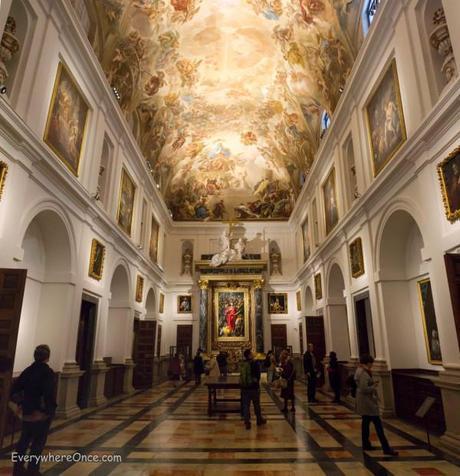
Just one room in the cathedral’s museum
If museums are your thing, don’t miss Museo del Greco (€3). We normally skip right past most 16th century Christian paintings. Neither the style nor the subject matter really interests us. El Greco, though, is a revelation. His use of color, elongated forms, and non-linear lines give a mystical, somewhat dreamy, feeling to his works; almost like you’re viewing his subjects from underwater. Not surprisingly, this breaking from the classicist traditions was controversial at the time, but El Greco is now thought to be a progenitor of both the Expressionist and Cubist styles.
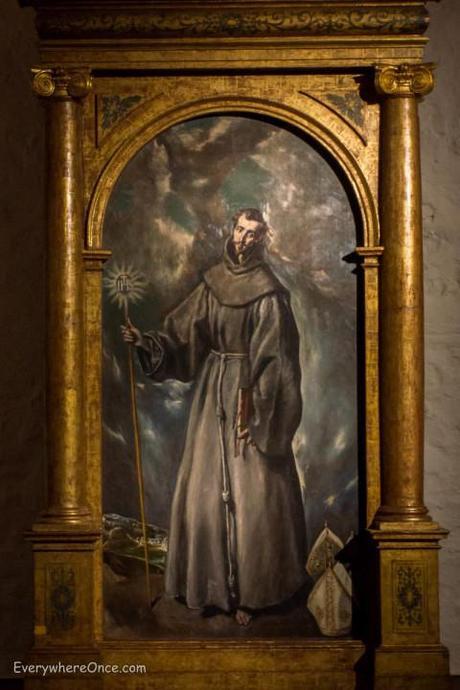
El Greco’s Altarpiece of St. Bernardine, Museo del Greco
Fortunately, not everything in Toledo charges admission. Like Segovia, the city itself is a work of art. Wonderful architecture is free to admire around every cobblestone clad corner. You could easily spend the better part of an entire day just exploring the towering gates and stone bridges that helped protect this fortified city for more than one thousand years.
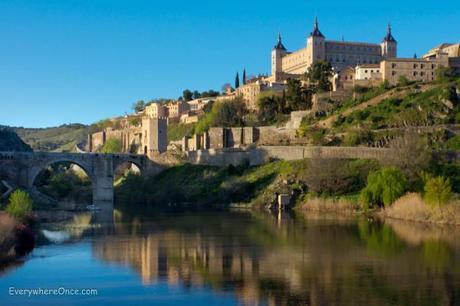
So when asked whether one should go to Toledo or Segovia the easy answer is “Yes.” The harder choice is deciding which of these two great places to skip.
39.862832 -4.027323
